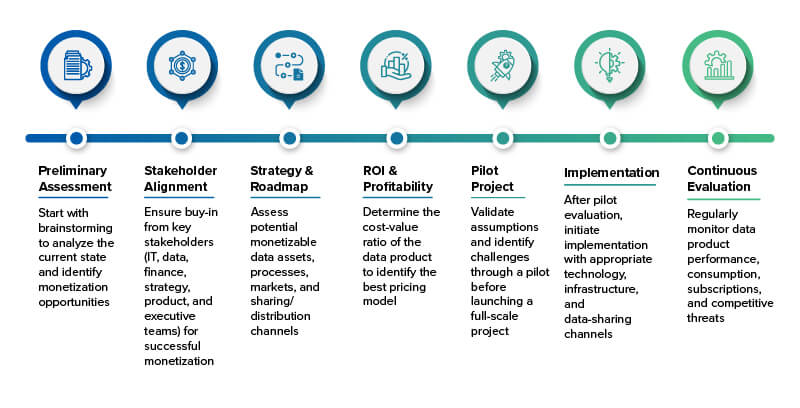This website uses cookies. By continuing to browse the site, you are agreeing to our use of cookies
Empower your Enterprise Data : Hexaware’s Guide to Effective Data Monetization Using Modern Cloud Data Platforms
Data & Analytics
June 23, 2023
Introduction
Over the years, businesses have reached a significant realization of embracing the pivotal role of data in today’s business landscape. In the past, organizations realized the value of data for decision-making. However, today, as they collect an unprecedented volume of data, they have also begun exploring ways to monetize it. Hence, data could be coined as a new form of digital currency vital to business growth and success.
Data Monetization is the process of generating measurable economic benefits by utilizing your data directly through data sharing with customers or indirectly to make quantifiable business performance improvements.
But unlike other currencies, data tends to lose value over time. Hence, it is crucial for organizations to capitalize on its worth while it is still valuable and relevant.
Data monetization is not a new concept. Businesses running with data/information as their primary product/service have long been familiar with the nuances of data monetization, building business models around data, and the technical know-how of executing the monetization plan. But the concept has also started attracting much interest in organizations where data or information is not the primary product/service offering.
Today, not every organization is at the same stage of the data monetization journey. We have classified them into two broad categories, outlined below and further elaborated in the blog, discussing strategies and approaches for each category.
- Type 1: Companies trying to venture into data monetization as a new revenue stream.
- Type 2: Companies already monetizing data but seeking to enhance their monetization operations by leveraging the latest data technologies.
For better understanding, let’s refer to these organizations as Type 1 and Type 2 in the following sections of the article.
How can we get started?

Figure 1: Classification of Buyer Personas
For Type 1 organizations, it is essential to begin with an assessment to prepare a customized strategy and roadmap that aligns with their specific needs.

For Type 2 organizations, data monetization is a crucial priority encompassing two key aspects. Firstly, they must optimize technology and processes for efficient data/information sharing. Secondly, they must drive customer adoption and consumption to preserve the value of data and its products. To prioritize improvement actions, these enterprises should assess both fronts.

How do we get there?
Implementing data monetization for Type 1 organizations is challenging as they explore a new revenue source while dealing with the declining value of data over time.
After the assessment and the roadmap are laid out, the organization should quickly mobilize by implementing robust data management and transformation processes to centrally aggregate and analyze data. Opting for specialized tools and platforms can be an essential step to accelerate the implementation of these practices and policies. It should not be averse to exploring modern cloud-based platforms that are scalable. When exchanging data, it is crucial to implement the right governance, compliance, and security policies from the start.
Type 2 organizations can prioritize either technology enhancements, data delivery improvements, or preserving and strengthening the value of the data being shared with external customers. Based on our experience, customer implementations of data exchange systems often involve setting up dedicated database instances to facilitate data provision. This method of data delivery is highly unscalable and hinders performance as the customer base increases. This would call for scalable, multi-tenant, secured data platforms that provide capabilities for live data sharing.
- To overcome current technological and delivery challenges, organizations can leverage the latest data management and sharing capabilities offered by cloud platforms, such as Snowflake, to make the process more robust and efficient.
- To enhance the value of their data products, organizations can explore opportunities to generate new insights from existing data or augment it with external/third-party data.
Implementing new solutions for Type 1 organizations and re-architecting/re-platforming for Type 2 organizations demand significant data engineering and migration efforts. Faster time to market demands platforms and accelerators that can partially automate the data management processes around the data sharing implementation.
For example, Hexaware’s migration and modernization platform, Amaze® for Data & AI, would help automate the engineering and migration efforts around building the data-sharing platforms. Our platform enables the automation of migration artifacts, resulting in cost savings of up to 60% during implementation.
We have successfully implemented data exchange and sharing solutions for our customers across industry verticals, leveraging Amaze® for Data & AI.
How can we effectively build, deploy, and extract optimal value from the platform to accomplish our business goals?
Data monetization should be viewed as more than just a standalone activity within organizations. It should be treated as a distinct product/offering requiring participation from technology and business stakeholders. While technology teams concentrate on developing data exchange/sharing platforms while adopting monetization, it is crucial not to lose sight of the business goals.
Pricing the data products and services is also equally important. The price-to-value ratio should be compelling and demonstrable to consumers. Moreover, leveraging cloud data platforms like Snowflake for data monetization entails monitoring platform costs, consumption, usage, and attribution.
Improving data asset value involves integrating internal and external datasets for unique perspectives, insights, and better analysis. New analytical models further provide fresh insights and reveal data correlations. Additionally, adopting interactive data apps rather than static data fosters scenario simulations and experiments.
How do we future-proof?
The data monetization journey reaches a pivotal point when the consumption of data products and services decreases, signaling a decline in value and appeal. To address this, enterprises must establish a framework to continuously monitor the consumption and usage of current subscriptions and periodically evaluate the competition to ensure differentiation and a superior value proposition.
We have worked with our customers to devise “product metrics” and build solutions for monitoring the “data product usage analytics” that will keep the stakeholders informed about data product usage trends among their customers. Product usage analytics must be capable of continually collecting usage data, detecting deviations and anomalies, identifying trends, and providing recommendations to the stakeholders.
Future-proofing data products and services would require a periodic evaluation of their value and relevance to their consumers, along with identifying avenues to improve their value proposition. In the previous section, we have mentioned a few ways to enhance the value proposition.
As business and market scenarios evolve, certain data products and services naturally diminish in value over time. Therefore, it is essential to assess and understand their current state, determining whether to enhance, replace, or remove them from the marketplace.
How do we maintain governance, observability, security, and controls once we have reached our goal?
One of the crucial steps in monetizing data by data sharing is to ensure governance, compliance, security, and control over it. Having efficient data governance and data observability implementation ensures that the data is of high quality and is consistent and reliable. Consumers should be highly confident in the data products they subscribe to and utilize.
With GDPR and other regulations governing the usage and storage of data, organizations should also establish high security, compliance, and control policies to ensure their product adheres to these governance and compliance requirements.
Data sharing platforms like Snowflake enables live sharing through consumers’ own Snowflake accounts or data provider-provisioned reader accounts. In either case, securing the data with necessary role-based access controls is crucial, masking sensitive data wherever applicable.
The data-sharing platforms must also have high availability, and the shared data sets must be as current and up to date as possible. Stale data inhibit usage and reduce trust in the data and the provider. The complexity of the data pipelines and data management processes often makes these platforms prone to more data issues and incidents, resulting in delayed data delivery.
Therefore, it is essential to bring visibility and observability into the data ecosystem through appropriate tools and techniques to help the data teams address the issues and incidents faster.
Hexaware has proprietary platforms and accelerators that deliver observability into cloud data ecosystems, providing insights and recommendations into data platform infrastructure (for on-premises or IaaS types), data pipelines, and cloud consumption costs.
Proof points
Hexaware has successfully delivered strategic data-sharing and monetization engagements to our prominent clients, exemplified by the following cases:
- Enabled a global life science organization with a human data science cloud solution on Snowflake, achieving 75% faster data cleansing, reduced time for data insights, and a 50% decrease in TCO.
- Implemented an integrated data exchange platform for a leading financial services provider, combining data lake, data warehouse, and analytics workloads, resulting in a 30-40% lower TCO.
- Built a front-to-back data platform on Snowflake for a prominent US asset manager, leveraging third-party data sources to accelerate insights by 75% with self-service analytics.
For more detailed insights about how Hexaware’s Amaze® for Data & AI can accelerate your journey to Snowflake swiftly and efficiently, please contact us at marketing@hexaware.com.
About the Author

Natarajan Ganapathi
Data & AI Solutions Leader
Natarajan Ganapathi is Data & AI Solutions leader at Hexaware, where he is helping customers with his deep expertise across full data stack covering data strategy, architecture, engineering, machine learning, and data governance. With a proven track record of leading complex data strategies and large-scale Data & AI transformations, Natarajan is committed to making data work best for business.
Read more
About the Author

James Gardner
James has guided companies in using cloud and automation technologies to transform their businesses. He is dedicated to helping customers take their businesses to the next level with best-in-class technology and process improvement. He is responsible for driving Hexaware’s value proposition, service offerings, and futuristic thinking to assist clients in their cloud-enabled digital transformation.
Read more
Related Blogs

Enterprise Data Services: The Backbone of Modern Businesses
- Data & Analytics

Navigating Databricks’ Delta Lake Features and Type Widening
- Data & Analytics

Top 13 Data Science Services Providers: Bridging the Gap Between Data Capabilities and AI Strategy
- Data & Analytics

The Role of AI in Automating SAS to PySpark Conversion and Accelerating Data Migration
- Data & Analytics

How to Achieve New Standards in Data Quality and Observability using Databricks Lakehouse Monitoring
- Data & Analytics

Retrieval-Augmented Generation (RAG) on Amazon Bedrock
- Data & Analytics

Databricks Unity Catalog for Comprehensive Data Governance
- Data & Analytics

Ready to Pursue Opportunity?
Every outcome starts with a conversation










